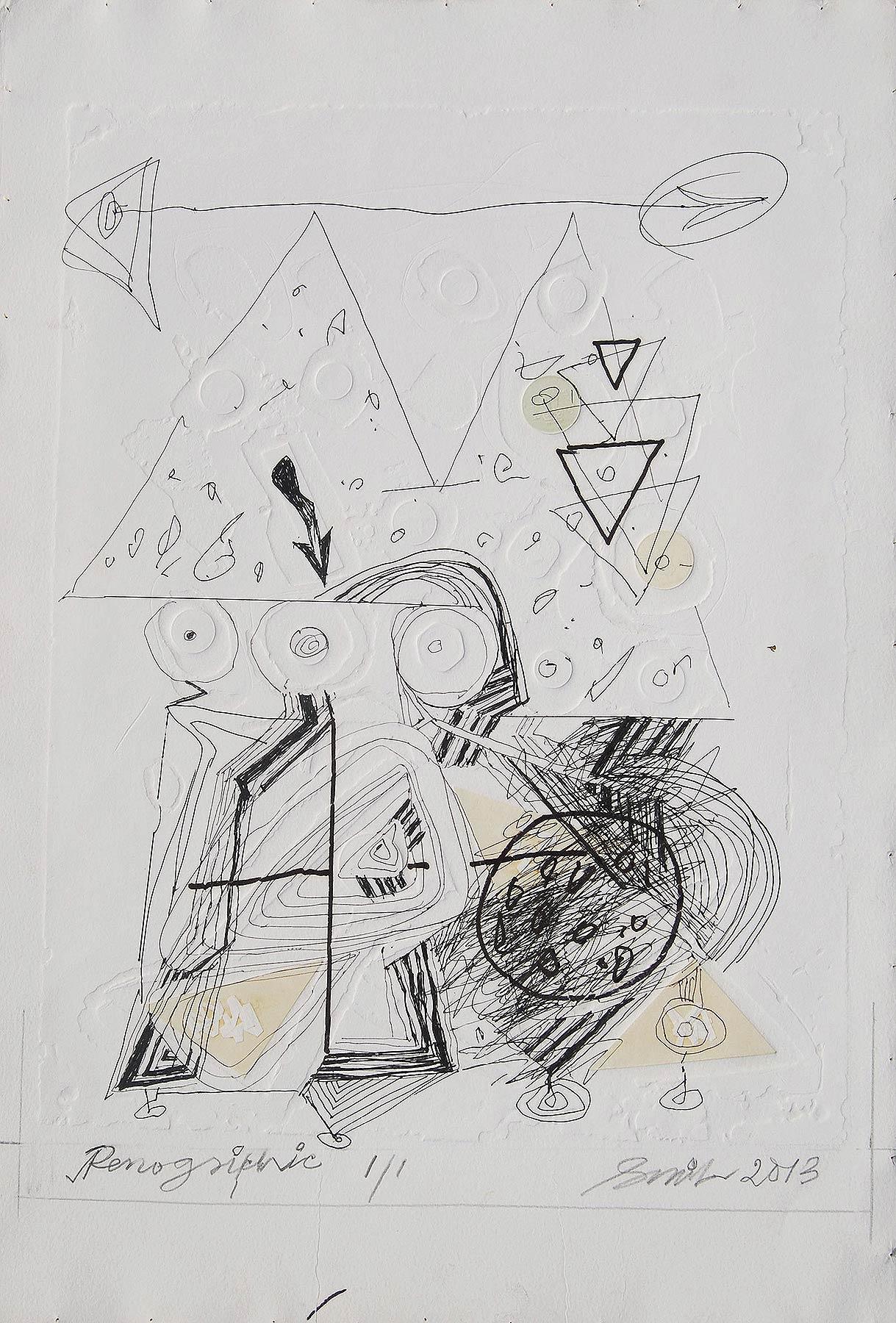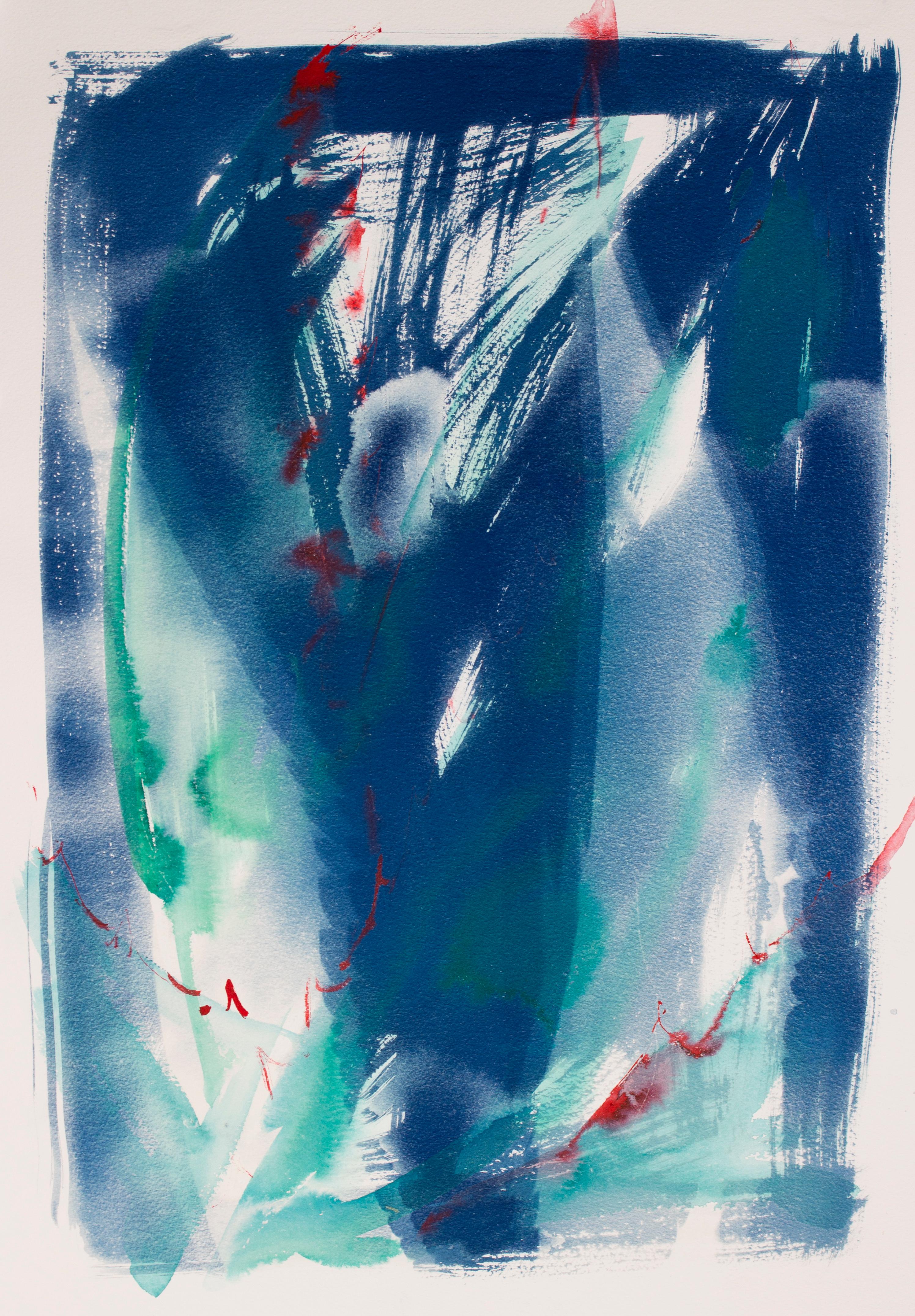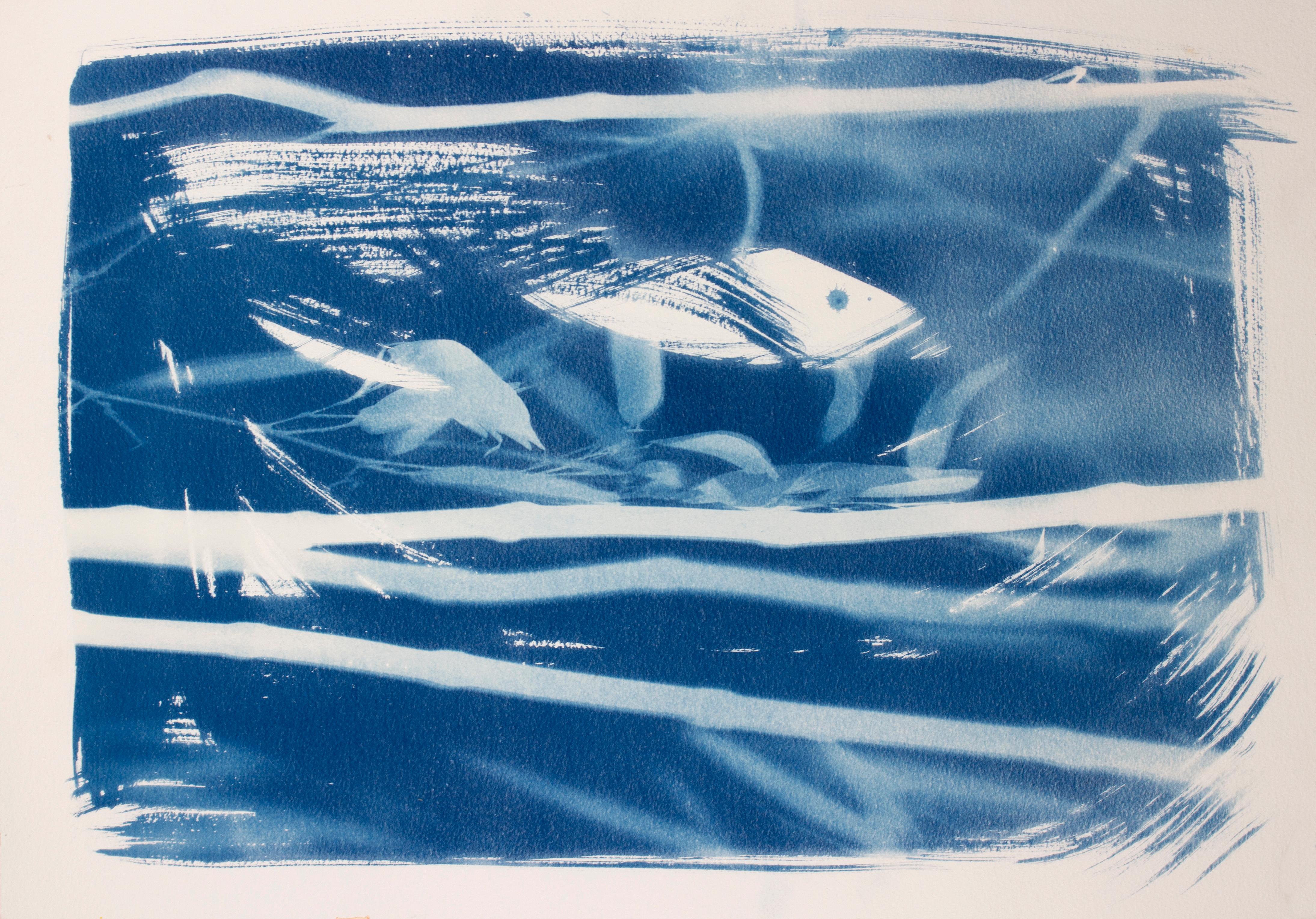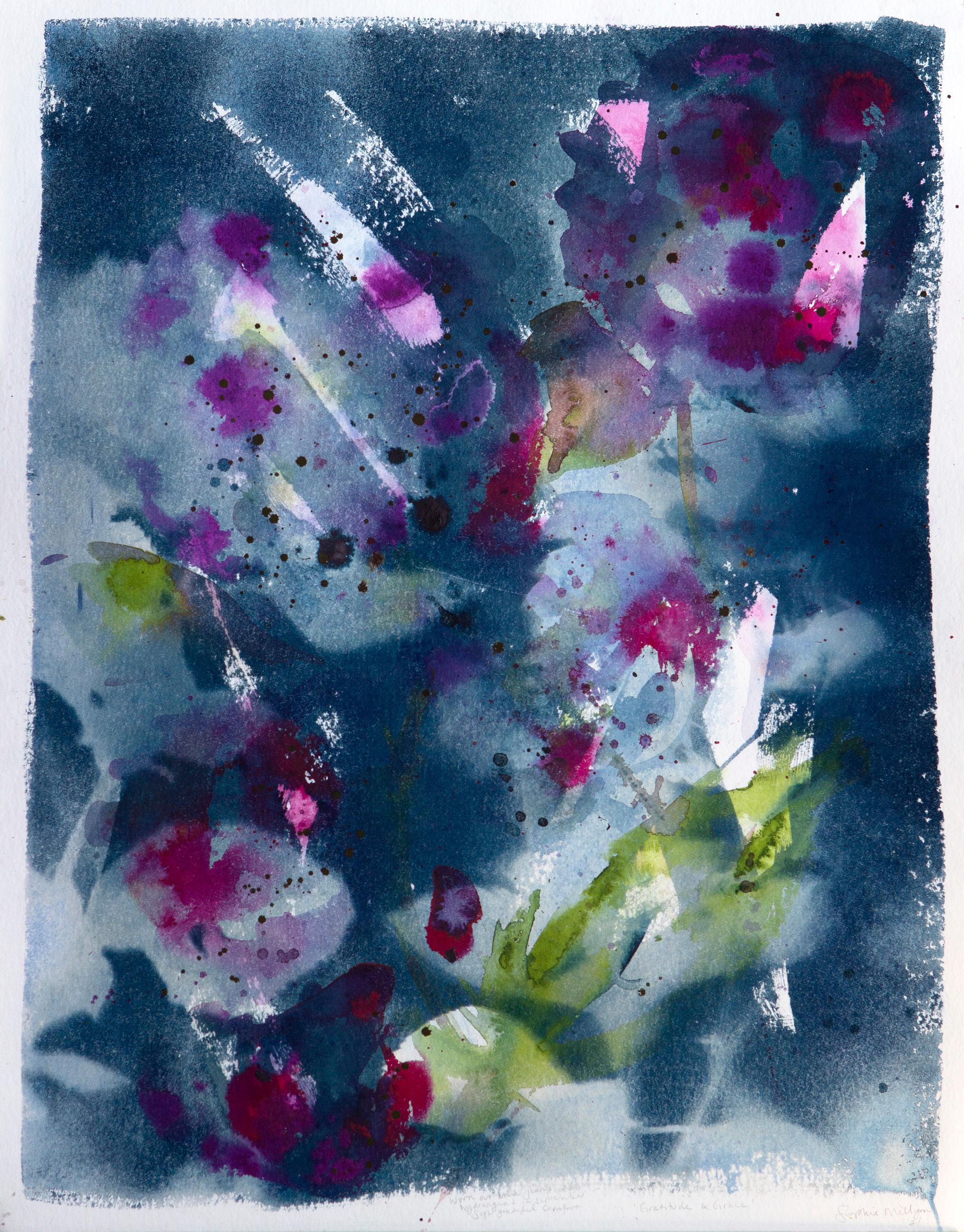Items Similar to Canadian Art Mixed Media Collage Assemblage Painting Hebrew Canada Stamp
Want more images or videos?
Request additional images or videos from the seller
1 of 10
Stephen AndrewsCanadian Art Mixed Media Collage Assemblage Painting Hebrew Canada Stamp
About the Item
Canadian artist, designer, teacher and writer Stephen James Andrews was born in Saskatoon, Saskatchewan in 1922. Studied art at Winnipeg School of Art, Winnipeg, Manitoba, Camberwell School of Arts, London, England, privately with Martin Bloch in London, England, at the Académie Julian, Paris, France, and the Scuola del Mosaics, Ravenna, Italy. Died in Spain in 1995. A collage may sometimes include magazine and newspaper clippings, ribbons, paint, bits of colored or handmade papers, portions of other artwork or texts, photographs and other found objects, glued to a piece of paper or canvas. This is more of a photomontage. Modernist collage began with Cubist painters Georges Braque and Pablo Picasso. Many artists have used the technique including Enrico Baj, Joseph Cornell, Max Ernst, Man Ray, Mimmo Rotella and Kurt Schwitters. Drawings made by Stephen Andrews during a performance of Christopher Fry's play, The Lady's Not For Burning at the Globe Theatre (now the Gielgud), 1950 were commissioned by John Gielgud. Christopher Fry received two and each of the cast was given one. Andrews gave the remaining six drawings to the V&A Museum.
- Creator:Stephen Andrews (1922 - 1995)
- Dimensions:Height: 12.5 in (31.75 cm)Width: 10 in (25.4 cm)
- Medium:
- Movement & Style:
- Period:
- Condition:
- Gallery Location:Surfside, FL
- Reference Number:1stDibs: LU3827862582
About the Seller
4.9
Platinum Seller
These expertly vetted sellers are 1stDibs' most experienced sellers and are rated highest by our customers.
Established in 1995
1stDibs seller since 2014
1,541 sales on 1stDibs
Typical response time: 1 hour
- ShippingRetrieving quote...Ships From: Surfside, FL
- Return PolicyA return for this item may be initiated within 3 days of delivery.
More From This SellerView All
- Original California Figurative Abstract Still Life Ink Drawing Joyce TreimanBy Joyce TreimanLocated in Surfside, FLJoyce Treiman Ink on paper, framed under glass; signed in pencil lower right; Dimensions: 16 1/2 x 13 3/4 inches; 18 3/4 x 14 3/4 inches frame. Joyce Wahl Treiman was an American painter, printmaker, sculptor and teacher. Her work ranged from "the impishly perverse and humorously paradoxical to the brilliant and profound." She was known as an excellent draftsperson throughout her career. She made several trips to Europe to study the old masters, and the human figure is central in her work. In her later paintings she is known to have inserted self-portraits. She attended Stephens College in Columbia, Missouri, and then studied at the State University of Iowa (today the University of Iowa) under the influential painter Philip Guston. During World War II she worked as a commercial artist but resigned when she began to have success with exhibitions of her work in Chicago and New York. In 1945 she married Kenneth Treiman, and son Donald, now an Architect, was born in 1950. The Treimans, along with Rene and Rose Wahl, moved to Los Angeles in 1960. She was in an exhibit of Tamarind prints...Category
Mid-20th Century American Modern Abstract Paintings
MaterialsIndia Ink, Paper
- Leonard Baskin Watercolor Ink Illustration Painting Darkened Man, Nude with BirdBy Leonard BaskinLocated in Surfside, FLLeonard Baskin (American, 1922-2000) ink and gouache drawing on paper titled "Darkened Man", signed lower right, circa 1957. Provenance: Grace Borgenicht gallery, Jeffrey M. Kaplan collection. bears label verso Art: 31" H x 22" W; Frame: 36" H x 27" W. Leonard Baskin was an American sculptor, illustrator, wood-engraver, printmaker, graphic artist, writer and teacher. Baskin was born in New Brunswick, New Jersey. While he was a student at Yale University, he founded Gehenna Press, a small private press specializing in fine book production. From 1953 until 1974, he taught printmaking and sculpture at Smith College in Northampton, Massachusetts. Subsequently Baskin also taught at Hampshire College in Amherst, Massachusetts. He lived most of his life in the U.S., but spent nine years in Devon at Lurley Manor, Lurley, near Tiverton, close to his friend Ted Hughes, for whom he illustrated Crow. Sylvia Plath dedicated Sculpto to Leonard Baskin in her famous work, The Colossus and Other Poems (1960). The Funeral Contege (1997) bronze, Franklin Delano Roosevelt Memorial, Washington, D.C. His public commissions include a bas relief for the Franklin Delano Roosevelt Memorial and a bronze statue of a seated figure, erected in 1994 for the Holocaust Memorial in Ann Arbor, Michigan. His works are owned by many major museums including the Metropolitan Museum of Art, the Museum of Fine Arts, Boston, the Museum of Modern Art, the Art Institute of Chicago, the Boca Raton Museum of Art, the British Museum, the Honolulu Museum of Art, the Udinotti Museum of Figurative Art and the Vatican Museums. The archive of his work at the Gehenna Press was acquired by the Bodleian Library at Oxford, England, in 2009. The McMaster Museum of Art in Hamilton, Ontario owns over 200 of his works (some religious and biblical), most of which were donated by his brother Rabbi Bernard Baskin. He was included in the MoMA show, Summer Exhibition: New Acquisitions; Recent American Prints, 1947–1953; Katherine S. Dreier Bequest; Kuniyoshi and Spencer; Expressionism in Germany; Varieties of Realism along with Alexander Archipenko, Francis Bacon, Balthus, Will Barnet, Leonard Baskin, Eugene Berman, Reg Butler, Lovis Corinth, Andre Derain, Otto Dix, Raoul Dufy, Max Ernst, Lucian Freud, George Grosz, Alexei Jawlensky, Oskar Kokoschka, Roberto Matta, Man Ray, Marcel Duchamp and more. In 1955, he was one of eleven New York artists featured in the opening exhibition at the Terrain Gallery, they showed many great artists, Chaim Koppelman, for many years, headed the gallery's Print Division; printmakers such as Will Barnet, Leonard Baskin, Robert Conover, Edmond Casarella, Vincent Longo, and Nicholas Krushenick were frequent exhibitors. the gallery has represented many well-known artists, including Richard Anuszkiewicz, Robert Blackburn, Lois Dodd, William King, Chaim and Dorothy Koppelman, Roy Lichtenstein, Harold Krisel...Category
1950s Modern Figurative Drawings and Watercolors
MaterialsIndia Ink, Watercolor
- Polish French Judaica Watercolor Gouache Painting Original Bauhaus Yiddish ArtBy Moses Bagel BahelferLocated in Surfside, FLMoses Bahelfer BAGEL (1908-1995) Moses Bagel (born Moshe Bahelfer) was a Polish-born Jewish artist and graphic designer associated with the original Bauhaus and then the School of Paris (Ecole de Paris) Moshe Bagelferyches was born on June 29 , 1908 in Vilnius, (Vilna, Poland) then part of the Russian Empire. He took up painting from at an early age, later going on to work as an apprentice at a local vocational school in Vilno while taking classes at the Vilnius Academy of Arts. Bagelferyches also joined Yungvilno, a group formed by young Jewish artists, poets and writers in the city, who hosted exhibitions. In 1927, he left for Germany where he joined the Bauhaus arts and architecture school in Dessau. From 1928 to 1932, he studied under Joost Schmidt, Paul Klee, Lyonel Feininger, and Wassily Kandinsky. His painting was close to pure abstract art. He maintained close bonds with former students of the Bauhaus school who lived in Paris, Joseph Weinfeld, Jean Leppien...Category
20th Century Modern Figurative Drawings and Watercolors
MaterialsInk, Watercolor, ABS
- Polish French Judaica Watercolor Gouache Painting Original Bauhaus Yiddish ArtBy Moses Bagel BahelferLocated in Surfside, FLMoses Bahelfer BAGEL (1908-1995) Moses Bagel (born Moshe Bahelfer) was a Polish-born Jewish artist and graphic designer associated with the original Bauhaus and then the School of Paris (Ecole de Paris) Moshe Bagelferyches was born on June 29 , 1908 in Vilnius, (Vilna, Poland) then part of the Russian Empire. He took up painting from at an early age, later going on to work as an apprentice at a local vocational school in Vilno while taking classes at the Vilnius Academy of Arts. Bagelferyches also joined Yungvilno, a group formed by young Jewish artists, poets and writers in the city, who hosted exhibitions. In 1927, he left for Germany where he joined the Bauhaus arts and architecture school in Dessau. From 1928 to 1932, he studied under Joost Schmidt, Paul Klee, Lyonel Feininger, and Wassily Kandinsky. His painting was close to pure abstract art. He maintained close bonds with former students of the Bauhaus school who lived in Paris, Joseph Weinfeld, Jean Leppien...Category
20th Century Modern Figurative Drawings and Watercolors
MaterialsInk, Watercolor, ABS
- Polish French Judaica Watercolor Gouache Painting Original Bauhaus Yiddish ArtBy Moses Bagel BahelferLocated in Surfside, FLMoses Bahelfer BAGEL (1908-1995) Moses Bagel (born Moshe Bahelfer) was a Polish-born Jewish artist and graphic designer associated with the original Bauhaus and then the School of Paris (Ecole de Paris) Moshe Bagelferyches was born on June 29 , 1908 in Vilnius, (Vilna, Poland) then part of the Russian Empire. He took up painting from at an early age, later going on to work as an apprentice at a local vocational school in Vilno while taking classes at the Vilnius Academy of Arts. Bagelferyches also joined Yungvilno, a group formed by young Jewish artists, poets and writers in the city, who hosted exhibitions. In 1927, he left for Germany where he joined the Bauhaus arts and architecture school in Dessau. From 1928 to 1932, he studied under Joost Schmidt, Paul Klee, Lyonel Feininger, and Wassily Kandinsky. His painting was close to pure abstract art. He maintained close bonds with former students of the Bauhaus school who lived in Paris, Joseph Weinfeld, Jean Leppien...Category
20th Century Modern Figurative Drawings and Watercolors
MaterialsInk, Watercolor, ABS
- Polish French Judaica Watercolor Gouache Painting Original Bauhaus Yiddish ArtBy Moses Bagel BahelferLocated in Surfside, FLMoses Bahelfer BAGEL (1908-1995) Moses Bagel (born Moshe Bahelfer) was a Polish-born Jewish artist and graphic designer associated with the original Bauhaus and then the School of Paris (Ecole de Paris) Moshe Bagelferyches was born on June 29 , 1908 in Vilnius, (Vilna, Poland) then part of the Russian Empire. He took up painting from at an early age, later going on to work as an apprentice at a local vocational school in Vilno while taking classes at the Vilnius Academy of Arts. Bagelferyches also joined Yungvilno, a group formed by young Jewish artists, poets and writers in the city, who hosted exhibitions. In 1927, he left for Germany where he joined the Bauhaus arts and architecture school in Dessau. From 1928 to 1932, he studied under Joost Schmidt, Paul Klee, Lyonel Feininger, and Wassily Kandinsky. His painting was close to pure abstract art. He maintained close bonds with former students of the Bauhaus school who lived in Paris, Joseph Weinfeld, Jean Leppien...Category
20th Century Modern Figurative Drawings and Watercolors
MaterialsInk, Watercolor, ABS
You May Also Like
- Penographic III, White, Black Colour Drawing by Indian Artist "In Stock"By Sunil DasLocated in Kolkata, West BengalSunil Das - Penographic III - 17 x 13 inches (unframed size) Penographic Series. Single Edition 1 / 1 (each). ( Unframed & Delivered ) Sunil Das (1939-2015) was a Master Modern Indi...Category
2010s Modern Abstract Paintings
MaterialsArchival Ink, Mixed Media, Watercolor, Archival Paper
- Surrealist Composition - Mixed Media Drawing- 20th CenturyLocated in Roma, IT"Surrealist Composition" is a drawing in mixed media on paper, ink and watercolor, realized by Anonymous Artist of the XX Century. The state of preservation of the artwork is very ...Category
20th Century Modern Abstract Drawings and Watercolors
MaterialsMixed Media, Ink, Watercolor
- 1950s Abstract Composition in Brown, Orange and Blue with Black Parallel LinesBy Herbert BayerLocated in Denver, COWatercolor and ink on paper of an abstract composition of brown, orange and blue shapes between black parallel lines throughout the the piece by Herbert Bayer (1900-1985). Presented in a custom black frame with all archival materials. Framed dimensions measure 17 ⅞ x 22 ⅝ x 1 inches. Image size is 10 ¼ x 15 ½ inches. Painting is clean and in very good condition - please contact us for a detailed condition report. Expedited and international shipping is available - please contact us for a quote. About the Artist: Herbert Bayer enjoyed a versatile sixty-year career spanning Europe and America that included abstract and surrealist painting, sculpture, environmental art, industrial design, architecture, murals, graphic design, lithography, photography and tapestry. He was one of the few “total artists” of the twentieth century, producing works that “expressed the needs of an industrial age as well as mirroring the advanced tendencies of the avant-garde.” One of four children of a tax revenue officer growing up in a village in the Austrian Salzkammergut Lake region, Bayer developed a love of nature and a life-long attachment to the mountains. A devotee of the Vienna Secession and the Vienna Workshops (Wiener Werkstätte) whose style influenced Bauhaus craftsmen in the 1920s, his dream of studying at the Academy of Art in Vienna was dashed at age seventeen by his father’s premature death. In 1919 Bayer began an apprenticeship with architect and designer, Georg Schmidthamer, where he produced his first typographic works. Later that same year he moved to Darmstadt, Germany, to work at the Mathildenhöhe Artists’ Colony with architect Emanuel Josef Margold of the Viennese School. As his working apprentice, Bayer first learned about the design of packages – something entirely new at the time – as well as the design of interiors and graphics of a decorative expressionist style, all of which later figured in his professional career. While at Darmstadt, he came across Wassily Kandinsky’s book, Concerning the Spiritual in Art, and learned of the new art school, the Weimar Bauhaus, in which he enrolled in 1921. He initially attended Johannes Itten’s preliminary course, followed by Wassily Kandinsky’s workshop on mural painting. Bayer later recalled, “The early years at the Bauhaus in Weimar became the formative experience of my subsequent work.” Following graduation in 1925, he was appointed head of the newly-created workshop for print and advertising at the Dessau Bauhaus that also produced the school’s own print works. During this time he designed the “Universal” typeface emphasizing legibility by removing the ornaments from letterforms (serifs). Three years later he left the Bauhaus to focus more on his own artwork, moving to Berlin where he worked as a graphic designer in advertising and as an artistic director of the Dorland Studio advertising agency. (Forty years later he designed a vast traveling exhibition, catalog and poster -- 50 Jahre Bauhaus -- shown in Germany, South America, Japan, Canada and the United States.) In pre-World War II Berlin he also pursued the design of exhibitions, painting, photography and photomontage, and was art director of Vogue magazine in Paris. On account of his previous association with the Bauhaus, the German Nazis removed his paintings from German museums and included him among the artists in a large exhibition entitled Degenerate Art (Entartete Kunst) that toured German and Austrian museums in 1937. His inclusion in that exhibition and the worsening political conditions in Nazi Germany prompted him to travel to New York that year with Marcel Breuer, meeting with former Bauhaus colleagues, Walter Gropius and László Moholy-Nagy to explore the possibilities of employment after immigration to the United States. In 1938 Bayer permanently relocated to the United States, settling in New York where he had a long and distinguished career in practically every aspect of the graphic arts, working for drug companies, magazines, department stores, and industrial corporations. In 1938 he arranged the exhibition, “Bauhaus 1919-1928” at the Museum of Modern Art, followed later by “Road to Victory” (1942, directed by Edward Steichen), “Airways to Peace” (1943) and “Art in Progress” (1944). Bayer’s designs for “Modern Art in Advertising” (1945), an exhibition of the Container Corporation of America (CAA) at the Art Institute of Chicago, earned him the support and friendship of Walter Paepcke, the corporation’s president and chairman of the board. Paepcke, whose embrace of modern currents and design changed the look of American advertising and industry, hired him to move to Aspen, Colorado, in 1946 as a design consultant transforming the moribund mountain town into a ski resort and a cultural center. Over the next twenty-eight years he became an influential catalyst in the community as a painter, graphic designer, architect and landscape designer, also serving as a design consultant for the Aspen Cultural Center. In the summer of 1949 Bayer promoted through poster design and other design work Paepcke’s Goethe Bicentennial Convocation attended by 2,000 visitors to Aspen and highlighted by the participation of Albert Schweitzer, Arthur Rubenstein, Jose Ortega y Gasset and Thornton Wilder. The celebration, held in a tent designed by Finnish architect Eero Saarinen, led to the establishment that same year of the world-famous Aspen Music Festival and School regarded as one of the top classical music venues in the United States, and the Aspen Institute for Humanistic Studies in (now the Aspen Institute), promoting in Paepcke’s words “the cross fertilization of men’s minds.” In 1946 Bayer completed his first architecture design project in Aspen, the Sundeck Ski Restaurant, at an elevation of 11,300 feet on Ajax Mountain. Three years later he built his first studio on Red Mountain, followed by a home which he sold in 1953 to Robert O. Anderson, founder of the Atlantic Richfield Company who became very active in the Aspen Institute. Bayer later designed Anderson’s terrace home in Aspen (1962) and a private chapel for the Anderson family in Valley Hondo, New Mexico (1963). Transplanting German Bauhaus design to the Colorado Rockies, Bayer created along with associate architect, Fredric Benedict, a series of buildings for the modern Aspen Institute complex: Koch Seminar Building (1952), Aspen Meadows guest chalets and Center Building (both 1954), Health Center and Aspen Meadows Restaurant (Copper Kettle, both 1955). For the grounds of the Aspen Institute in 1955 Bayer executed the Marble Garden and conceived the Grass Mound, the first recorded “earthwork” environment In 1973-74 he completed Anderson Park for the Institute, a continuation of his fascination with environmental earth art. In 1961 he designed the Walter Paepcke Auditorium and Memorial Building, completing three years later his most ambitious and original design project – the Musical Festival Tent for the Music Associates of Aspen. (In 2000 the tent was replaced with a design by Harry Teague.) One of Bayer’s ambitious plans from the 1950s, unrealized due to Paepcke’s death in 1960, was an architectural village on the outskirts of the Aspen Institute, featuring seventeen of the world’s most notable architects – Walter Gropius, Marcel Breuer, I.M. Pei, Minoru Yamasaki, Edward Durrell Stone and Phillip Johnson – who accepted his offer to design and build houses. Concurrent with Bayer’s design and consultant work while based in Aspen for almost thirty years, he continued painting, printmaking, and mural work. Shortly after relocating to Colorado, he further developed his “Mountains and Convolutions” series begun in Vermont in 1944, exploring nature’s fury and repose. Seeing mountains as “simplified forms reduced to sculptural surface in motion,” he executed in 1948 a series of seven two-color lithographs (edition of 90) for the Colorado Springs Fine Arts Center. Colorado’s multi-planal typography similarly inspired Verdure, a large mural commissioned by Walter Gropius for the Harkness Commons Building at Harvard University (1950), and a large exterior sgraffito mural for the Koch Seminar Building at the Aspen Institute (1953). Having exhausted by that time the subject matter of “Mountains and Convulsions,” Bayer returned to geometric abstractions which he pursued over the next three decades. In 1954 he started the “Linear Structure” series containing a richly-colored balance format with bands of sticks of continuously modulated colors. That same year he did a small group of paintings, “Forces of Time,” expressionist abstractions exploring the temporal dimension of nature’s seasonal molting. He also debuted a “Moon and Structure” series in which constructed, architectural form served as the underpinning for the elaboration of color variations and transformations. Geometric abstraction likewise appeared his free-standing metal sculpture, Kaleidoscreen (1957), a large experimental project for ALCOA (Aluminum Corporation of America) installed as an outdoor space divider on the Aspen Meadows in the Aspen Institute complex. Composed of seven prefabricated, multi-colored and textured panels, they could be turned ninety degrees to intersect and form a continuous plane in which the panels recomposed like pieces of a jigsaw puzzle. He similarly used prefabricated elements for Articulated Wall, a very tall free-standing sculpture commissioned for the Olympic Games in Mexico...Category
1950s Abstract Geometric Abstract Drawings and Watercolors
MaterialsPaper, Ink, Mixed Media, Watercolor
- 'Soldier Protects The Queen'. Botanical environmental mixed media paintingBy Sophia MilliganLocated in Penzance, GB'Soldier Protects The Queen' Original Artwork, Unframed ______________________ The sculptural strength of the agave, holding proud and protective, around the flashes of silken bloss...Category
2010s Abstract Impressionist Abstract Paintings
MaterialsPaint, Paper, Ink, Mixed Media
- 'Pasadena Reflections'. Conceptual, botanical painting in blue and whiteBy Sophia MilliganLocated in Penzance, GB'Pasadena Reflections' Original Artwork Memories rise and float, tangled in the intangible shadows of time. 'Pasadena Reflections' captures an essence of the ephemeral and the end...Category
2010s Abstract Impressionist Abstract Paintings
MaterialsPaint, Paper, Ink, Mixed Media
- 'Gratitude and Grace'. Botanical Blue Contemporary Abstract Floral PaintingBy Sophia MilliganLocated in Penzance, GB'Gratitude and Grace (Worn out Blue Jeans and Hydrangeas in September)' Original Artwork, Unframed _____________________ Early Autumnal nostalgia, hazy light on pillows of fading hy...Category
2010s Contemporary Abstract Paintings
MaterialsPaint, Pencil, Paper, Photogram, Ink, Mixed Media
Recently Viewed
View AllMore Ways To Browse
Vintage Art Stamps
Vintage Canada
Canada Made
Canadian Made
French Canada
Canadian Modern Art
Vintage Canadian Art
Modern Art Collage
French Canadian Artists
England Canada
Canadian Art 20th Century
Canadian Photographs
1950 Techniques Art
Canadian Designers
Vintage Assemblage
Academie Julian Paris
Canadian Stamps
Canada Stamps





